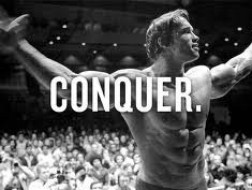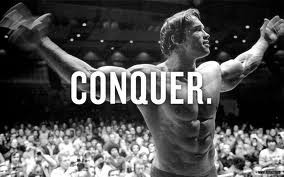Build a good strength base!

Before you worry too much about getting super lean, getting super big, getting fitter, becoming more skilled or more coordinated… GET STRONG FIRST. Strength is definitely the foundation of fitness. All human movement requires strength. The stronger you are, the harder you will be able to push and train, which will mean you will gain better results whether you want to gain fitness, build more lean muscle mass, perform better or look better. It will also mean building strong muscles around your joints and bones, which will protect them (very important)! No matter what your goals are, building strength should be a definite priority.
It's like laying down a foundation for building a house. You wouldn’t start adding the windows and doors if there is no framing built in yet. It’s the same for fitness. Once you have that nice well-rounded base of strength, then you can incorporate any type of training you are interested in, whatever you enjoy, knowing you have done your ground work. Whether it’s bodybuilding, MMA or other martial arts, powerlifting, speed work, Olympic lifting, running, dancing, CrossFit. Even endurance athletes benefit hugely from a couple of strength sessions a week in the gym. I would also include some of the tougher yoga practices to this list. I do Bikram yoga fairly regularly and I have noticed that the people who are stronger gain more out of the yoga than the weaklings.
Do you want to be an athlete? Do you want to compete? Do you want to get better at a sport? Do you want to be fast and powerful? Then get strong. You will be those few steps ahead of your game if you develop a good base of strength. Or maybe you don’t care about all the above, and you just want to look good and feel good? Then build solid strength. It will give you that well rounded, proportionate, athletic look and you will feel like a million bucks. No matter what your goals are, you will get the most bang for your buck by building a good strength foundation. Arnold Schwarzenegger wrote about this when he talks about bodybuilding in his biography:
From the beginning, I was a believer in the basic movements, because that was Reg Park's (his mentor’s) preference. I was doing heavy squats, heavy bench presses, and this provided some of the foundation work of my body, which has always made me appear strong. Certain bodybuilders lack that look. They have good bodies but they don’t appear powerful. The reason is inadequate foundation training. Reg Park had been a powerlifter; he had done squats with 600 pounds, bench presses with 500 pounds and dead lifts of over 700 pounds. I saw no reason why I shouldn’t continue in the same groove. - Arnold Schwarzenegger, The Education of a Bodybuilder
 I look at strength as the King of fitness training. Once you have developed strength, the sky is your limit as far as what direction you can go with your fitness routines and training. You don’t have to build superhero strength; just become strong enough with a good balance of strength throughout all the major muscle groups.
I look at strength as the King of fitness training. Once you have developed strength, the sky is your limit as far as what direction you can go with your fitness routines and training. You don’t have to build superhero strength; just become strong enough with a good balance of strength throughout all the major muscle groups.
Where do I start?
To work on your strength base, you may need to start with bodyweight resistance work first. There are so many bodyweight movements you can start with. Things like, air squats, push ups, burpees, pull ups, lunges, plank holds. Climbing/crawling-type movements are good to add in as well. These involve the whole body, open up the hips and help improve shoulder girdle strength and stability. Once you are ready to add weight, focus on the big, full-body lifts. You’ll see much better results if you do big “compound” moves that flood your body with the growth hormone it needs to build some good strength, while working every muscle in your body. Things like squats, deadlifts and shoulder presses.
One of the most underrated exercises, in my opinion, is the standing shoulder press. It works the entire shoulder girdle and the triceps very effectively and, when performed standing, recruits many of the core muscles and stabilizer muscles too (sexy abs anyone??). It’s also less punishing on the shoulder joints than the bench press. A great exercise for building that sweeeeet strength base.
Mark Rippetoe’s classic book, Starting Strength, is a good option for a strength training program if you don’t have access to a personal trainer or coach.
Building the neuromuscular connection:
You get stronger in one of two ways: 1. improving the efficiency of your nervous system or 2. increasing the size of your muscles. It might not be possible to continually increase the size of our muscles forever, but we can make consistent neural strength gains for quite some time if we are training properly. That’s how athletes in weight class sports are able to get continually stronger without gaining weight.
For beginners, the neuromuscular connection needs to be properly established before any weight is loaded. A lot of the time, the root of the problem is really that people are reinforcing poor movement patterns. Lack of strength can also reflect itself in a lack of coordination in certain movements. The body has deeply ingrained movement patterns that have been developed over the years, which can mean different muscles compensating in place of other deficiencies. Examples of things to watch out for are: the knees caving in when squatting, the back automatically rounding when picking up a barbell or dumbbells off the floor, the midsection and butt sinking in during push ups and plank holds.
The solution is not to add more weight and hope that the technique will suddenly improve. But rather learning to fix your technique before adding weight. Technique and efficiency go hand in hand. With technique will come efficiency and that efficiency means your ability to push harder will improve, which will mean better strength results. That’s a natural progression. When you have your neuromuscular connection switched on, everything else will fall into place. But proper motor control doesn’t just “happen”. It needs to be learned, often from scratch, and the nervous system needs to be trained. It takes repetition and concentration. Invest the time and effort into fixing your body’s movement patterns and learning how to perform the movements properly. You will get better results in the long run.
Learn to train with balance:
Nope, this doesn’t mean doing one-legged squats on a bosu ball. This is about preventing muscular imbalances from training, which can lead to injury. Most people already have some sort of postural imbalances naturally. It’s so important to keep your body balanced when starting a strength training routine. This means working your lower body and upper body equally, and doing pulling movements to balance out pushing movements. By evening out these two movements (pushing and pulling), we can assure better muscle balance in both size and strength, better proportions, as well as avoid the injuries that often accompany muscle imbalances between agonists (working muscles) and antagonists (muscles opposite of the working muscles).
Using free weights for your main lifts once you are ready and able to, will stimulate your core muscles much more than machines. They will also allow you to work one side at a time (unilateral work), which is extremely beneficial to add in to your training, because it’s so easy to let your strong side take on more of the work.
I am a big sucker for proper postural balance in training. Everything in your body is connected, from your neck, to your spine, to your hips, to your knees, to your ankles. Overusing one muscle group and under-using another, can have negative repercussions in your joints and muscles. I believe this is one of the most important aspects to remaining injury free in your training in the long term.
This includes using proper range of motion in all your movements. I will do another post dedicated to this soon.
Master mental strength:
The other big part to building a good strength base, and a very important aspect in my opinion, is building mental strength. To develop mental toughness, you must learn to do what is uncomfortable for you. You need to have the discipline to step out of the comfort zone that you train and live in. You have to learn to think like a champion. The body can take a lot more than the brain gives it credit for; acceptance of this fact and learning how to push beyond that uncomfortable point, is the biggest hurdle most people face. You need to train your mind to be strong too, not just your body.
One of my favourite books on this subject is “The New Mental Toughness Training” by James E. Loehr. In this book, he talks about a certain amount of discomfort that needs to be present in order to improve and that without this “personal confrontation” there can be little to no progress. This lack of “mental toughness” is the reason most people out there don’t train hard enough; it is also the reason most people never reach their fitness goals.
Another one of my favourite books of all times is Never Let Go: A Philosophy of Lifting, Living and Learning, by Dan John. I recommend reading it! It is so motivating and full of great advice.
The mind so often falters before the body. Once you lose the battle in your mind, it is over. Don’t be afraid to be a little tough on yourself and tough on your mind. Thrive on it. Master it. And the results will speak for themselves.
I’m going to wrap this post up with a quote from Bruce Lee: “If you always put limits on everything you do, physical or anything else. It will spread into your work and into your life. There are no limits. There are only plateaus, and you must not stay there, you must go beyond them!”
Join the other 10,000+ who get my best fitness, diet & mindset tips.




Comments